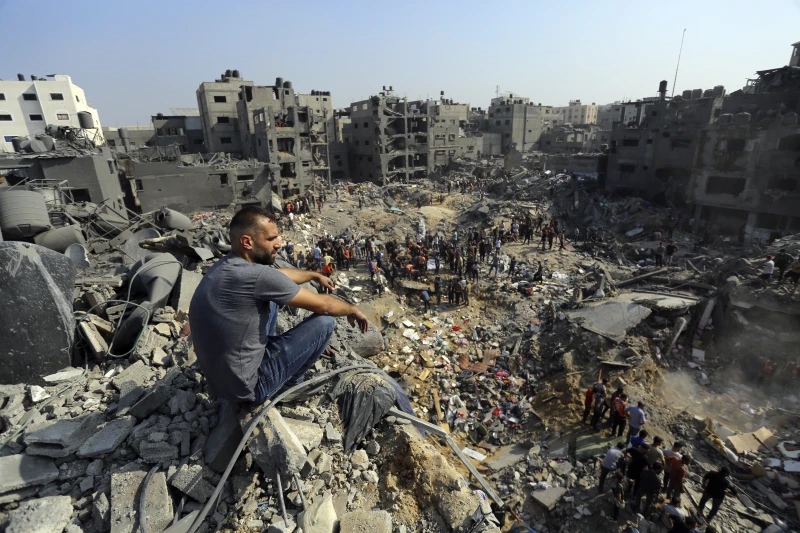The ongoing conflict in Gaza is exacting a devastating toll on civilians, raising concerns about the nature of urban warfare in this densely populated region. The Hamas-run health ministry reports that the death toll has surpassed 8,000, with a particularly distressing statistic – over 3,000 of those casualties are children. This figure alone exceeds the annual child death toll in all wars over the last three years. Satellite imagery analysis by The Economist estimates that over 10% of Gaza’s housing stock has been destroyed, leaving more than 280,000 people without homes to return to.
Urban warfare is renowned for its inherent destructiveness, but Israel’s military campaign in Gaza presents a distinctive set of challenges and consequences.
Comparing the casualties in Gaza to past urban conflicts provides a grim perspective. America’s first assault on Fallujah in 2004 resulted in up to 600 civilian deaths, or 0.2% of the population, while today’s conflict in Gaza stands at 0.3%. A second assault on Fallujah in the same year claimed an additional 800 lives, leaving the majority of the city’s buildings damaged. A significant battle in Sadr City, a suburb of Baghdad, during March and April 2008 resulted in the deaths of nearly 1,000 people, equivalent to Gaza’s population.
The largest urban battle in recent history was the assault on Mosul, which had been under the control of the Islamic State (IS) group. In Mosul, at least 9,000 civilians lost their lives during 2016-17, making up 0.6% of the population at that time. Moreover, over 80% of the damaged buildings were residential.
While these comparisons may suggest that the conflict in Gaza is not exceptionally destructive when viewed historically, there are key differences that set it apart.
First, the status of civilians stands out as a significant issue. In the case of Mosul, IS sought to prevent civilians from fleeing the city, firing upon them and mining escape routes. Despite these dangers, approximately 900,000 people left between October 2016 and June 2017, nearly half of the pre-war population. In contrast, Gaza’s geographic constraints limit evacuation options, leaving many civilians stranded and vulnerable.
Moreover, the civilian and military infrastructure in Gaza is tightly intertwined, a situation not seen in other conflicts. Hamas, which was founded in Gaza in 1987, has deep roots in the region and has governed the strip for 16 years. Its military defences are intricately built around and underneath civilian infrastructure, making it difficult to distinguish between military and non-military targets.
Tactics also play a crucial role in the consequences of urban warfare. Israel places a strong emphasis on civilian protection but has engaged in an intense bombardment of Gaza, surpassing historical standards. In the first six days of the conflict, Israel dropped 6,000 bombs on the territory, an ordnance rate higher than that seen in American and Western counter-terrorism campaigns. This level of firepower is significantly greater than what was deployed in Mosul, where the American-led coalition dropped 7,000 bombs over two months during the most intensive bombing period.
The stakes of the war, the nature of the enemy, and the presence of civilians all influence military tactics. For Israel, the conflict in Gaza is viewed as “existential,” with Israeli officials increasingly drawing parallels between Hamas and IS. This perception leaves little room for compromise, in contrast to the more nuanced approach of the Iraqi forces liberating their compatriots from IS rule.
The availability and role of medical facilities also vary significantly between conflicts. In past wars, Palestinian hospitals and civilian relief centers were considered non-strike areas according to Israeli military maps. However, in the current war, Israel has ordered the evacuation of northern Gaza, including hospitals, which it claims are used as Hamas command posts. While hospitals may lose their special protection under international law if they are used for military purposes, armies can only attack them “after due warning” and within a “reasonable time limit.”
In contrast, during the battle for Mosul, the city’s hospital was used as an IS stronghold, requiring a thorough deliberation process before being targeted. The Gaza situation presents a different challenge as hospitals are expected to evacuate and dismantle rapidly, which is often impractical.
Another critical difference in Gaza is the nature of battlefield intelligence. While the Israeli military possesses substantial intelligence on Hamas’s infrastructure, the Gaza campaign has forced them to shift from known targets to “dynamic” targeting, identifying and striking newly discovered targets in real-time. This phase is where the majority of civilian casualties tend to occur.
In Mosul, local civilians, despite their disdain for IS, provided valuable human intelligence to Iraqi forces, aiding them in targeting IS fighters. In Gaza, Hamas may have the intelligence advantage on the ground, with locals providing valuable information as the Israeli Defense Forces (IDF) advance. This shift in the human intelligence dynamic presents a greater challenge for the IDF, making their military operations more difficult and potentially leading to more civilian casualties.
In conclusion, the urban warfare in Gaza is both devastating and unique, marked by a series of distinctive challenges. Despite historical comparisons with previous conflicts, the combination of densely populated urban areas, intermingled civilian and military infrastructure, tactical considerations, medical facility issues, and evolving battlefield intelligence create a formidable and complex situation for all parties involved. As the conflict continues, the hardships faced by civilians in Gaza are likely to intensify, making it an ongoing humanitarian crisis of significant concern to the international community.




